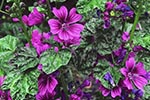Mallow Plants Are Safe for Cats and Dogs
Mallow Plants include Globemallow, Tree Mallow, Marsh Mallow and Common Mallow. They are not invasive or classified as weeds. Mallow is not poisonous to cats or dogs. You can safely include them in your pet safe gardens. I have found that they grow best in a place where they get a lot of sun on the foliage but shade on the roots so that they can stay moist. Since I try to “upcycle” to reduce waist in my container garden, I use old file baskets and milk crates for planters and mallow is one of the plants that just love that. I love the multi-colored blossoms but I’m not so in love with the dramatic death that occurs if you don’t deadhead regularly. I let some of mine go to seed and the spent blossoms were kind of unsightly. I will say that the tree squirrels made growing from seed challenging so you may want to put some kind of deterrent like scat-away or a net over the seedlings so that they have a chance.
Growing Tree Mallow in Pots Safe for Dogs
Before I started including tree and marsh mallow in Lovie’s Pet Safe Container Garden, I checked the ASPCA site and conducted extensive internet research for both the common and scientific name just to be super they both were pet safe because Lovie has free run in the garden with and without immediate supervision in the backyard. I am with him when he is in the front yard for his safety from passer-byers. As it turns out, both types of mallow grow well in Northern California, but need a lot of direct sunlight, so we grow ours on the southwest side of the house. As noted below, they both require good drainage but also like moist soil which would be easy in ground, but a little more challenging in a container. I have found that they flourish in recycled milk crates or old wire baskets that both provide great drainage. I water them daily with gray water when it’s warm and both types are hearty enough to thrive even with gray not fresh water.

Physical Attributes
Mallow flowers are showy, cup or funnel-shaped blooms in shades of pink, purple, red, orange, yellow or white. The flowers have 5 petals and a distinctive central column of fused stamens. Mallow plants have hairy, lobed leaves and can grow as annuals, biennials or perennials depending on the species. Heights range from 1-6 feet tall.[1][2][3]
General Care Tips
Plant mallow in full sun to partial shade and well-draining soil. Water regularly during the first growing season to establish a deep root system, then allow soil to dry slightly between waterings. Deadhead spent flowers to prolong blooming. Mallow is drought tolerant once established. Divide perennial types every 3-4 years to rejuvenate.[1][2][4]
Fun Facts
- The mallow family (Malvaceae) includes hibiscus, cotton, okra and hollyhocks.[2]
- Mallow leaves and flowers are edible with a mild, slightly mucilaginous flavor.[1][3]
- Native Americans used mallow roots and leaves for food and medicinal purposes.[3]
- The name “mallow” comes from the Greek word “malakos” meaning soft, referring to the plant’s demulcent properties.[1]
- Mallow attracts butterflies and hummingbirds to the garden.[2][4]
Citations:
[1] https://www.monrovia.com/be-inspired/lavender-plant-care-guide.html
[2] http://www.gardening.cornell.edu/homegardening/scene9108.html
[3] https://www.waysidegardens.com/blog/lavender-care-guide
[4] https://www.gardenia.net/guide/how-to-plant-care-grow-gorgeous-lavender
[5] https://extension.okstate.edu/fact-sheets/basic-plant-care-understanding-your-plants-needs.html
| Consideration | Details |
|---|---|
| Container Friendly | Yes, mallow can be grown in containers with good drainage.[1][2] |
| Indoor/Outdoor | Outdoor[1][2][3][4] |
| Sun/Shade | Full sun to partial shade[1][2][4] |
| Perennial/Annual | Can be annual, biennial or perennial depending on species[1][3] |
| Flowering | Showy, funnel-shaped flowers in pink, purple, red, orange, yellow, white[1][2][3] |
| Drought Tolerant | Yes, drought tolerant once established[1][2][4] |
| Pollinator Magnet | Yes, attracts butterflies, hummingbirds[2][4] |
| Beginner Friendly | Yes, relatively easy to grow[1][2][4] |
| Good Ground Cover | No, grows 1-6 feet tall[1][3] |
| Good Privacy Screen | Taller varieties could provide an informal screen |
| Invasive/Spreader | No, not considered invasive[1][2][3][4] |
| Hearty/Delicate | Hearty, tolerates heat and dry conditions[2][4] |
| Rodent Repellent | Unknown |
| Deer Resistant | Unknown, but hairy foliage may deter deer |
| Ideal States | Can be grown across many regions, native to parts of North America. Globemallow is native to California. [1][3] |
Citations:
[1] https://directives.sc.egov.usda.gov/48471.wba
[2] https://www.monrovia.com/be-inspired/lavender-plant-care-guide.html
[3] https://www.easytogrowbulbs.com/pages/lavender-lavandula-planting-guide
[4] https://www.gardenia.net/guide/how-to-plant-care-grow-gorgeous-lavender
[5] https://thursd.com/articles/plant-considerations-for-your-poolside-oasis





